This is a continuation of a test of the following lenses on the Sony a7RII:
- Zeiss 85mm f/1.8 Batis.
- Zeiss 85mm f/1.4 Otus.
- Leica 90mm f/2 Apo Summicron-M ASPH.
- AF-S Nikkor 85mm f/1.4 G.
- Sony 90mm f/2.8 FE Macro.
The test starts here.
Yesterday, I showed you the results of on-axis LoCA testing of the Batis and the Summicron. Today, I’ll present the results of the same tests as performed on the Otus and the Nikon 85mm lenses. I’ll present the results together so you can see the differences clearly.
To prepare you for what you are about to see, remember that the Nikon is a perfectly good lens. When I comes to on-axis LoCA, however, the Otus is a great one.
I lit the target with two Westcott LED panels, and set the color temperature to 5000K. I mounted a Sony a7RII to the Cognisys computer-driven focusing rail. I set the controller up to use 192mm of travel and make 49 exposures 4mm apart. I set the assembly 3.3 meters from the on-axis target, mounted the lenses in turn, focused about mid-rail using manual focusing , and exposed at 49-shot series from f/2 through f/8. I used Jack Hogan’s Matlab program, MTF Mapper, and DCRAW to pick the horizontal edges and calculate the MTF50s for the raw color planes, imported the data into Excel, and plotted the results in cycles per picture height vs image distance change.
At f/1.4:
You can see that the Nikon isn’t as sharp. You can also seen that the LoCA, as evidenced by the differences among the curves for the three color planes, aren’t in the same area code. You can also see by the way the Nikon curves spread more than the Otus, that the Nikon has more effective depth of field relative to peak sharpness, even though the apertures are the same.
At f/2:
Both lenses are substantially sharper, but the Nikon is still way behind. The Otus LoCA is about the same. The Nikon’s is getting a bit worse.
At f/2.8:
LoCa about the same as at f/2.
At f/4:
Now the Nikon per-channel sharpness is in the Otus ballpark, but the LoCA is not. Note that if we computed a luminance MTF50, the Nikon would suffer because of the different locations of the red and blue/green peaks.
At f/5.6:
For the Otus, the depth of field has essentially swamped out the LoCA. That’s not true for the Nikon.
At f/8:
Even at f/8, the LoCA effects of the Nikon are quite distinctive.
I guess that’s one of the things you pay Zeiss all that money for.
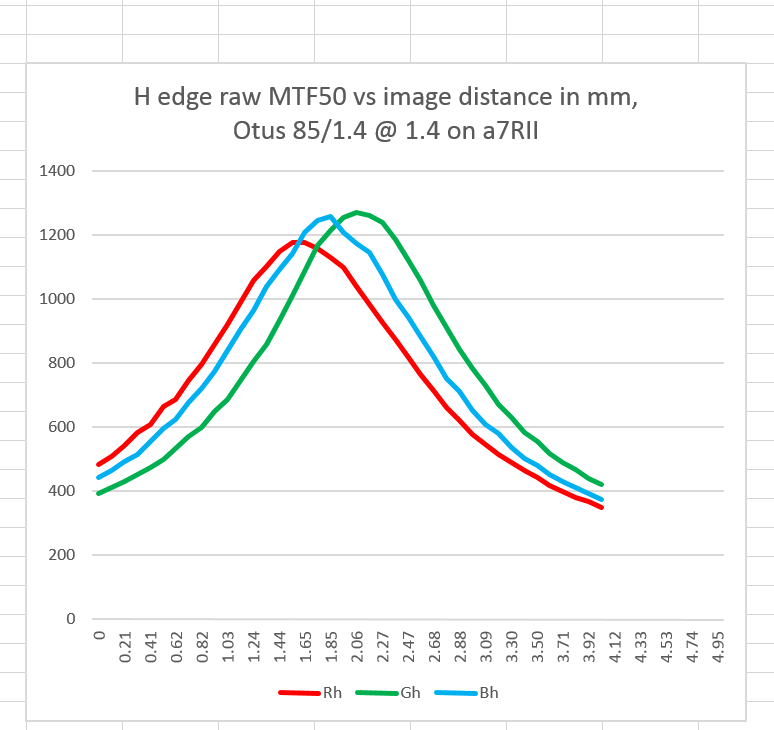
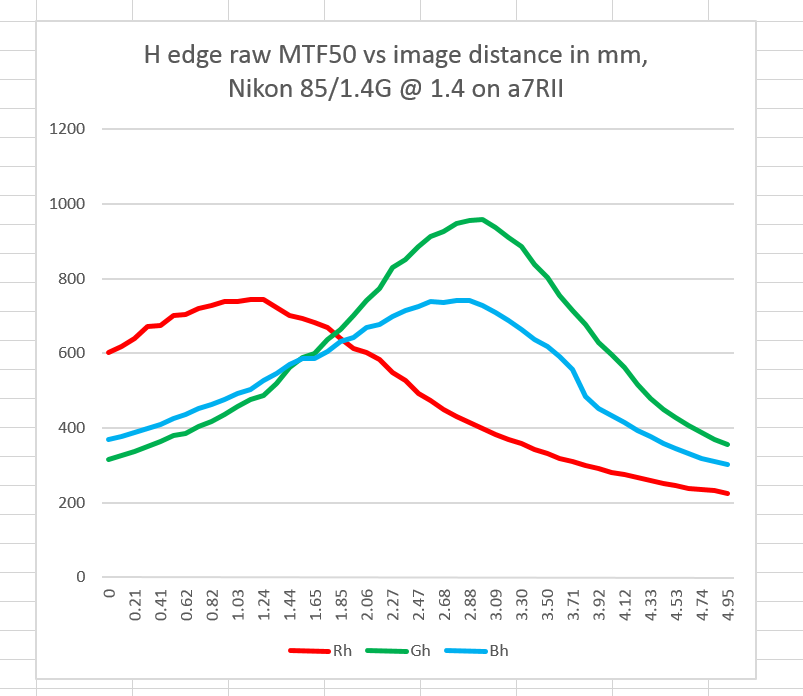
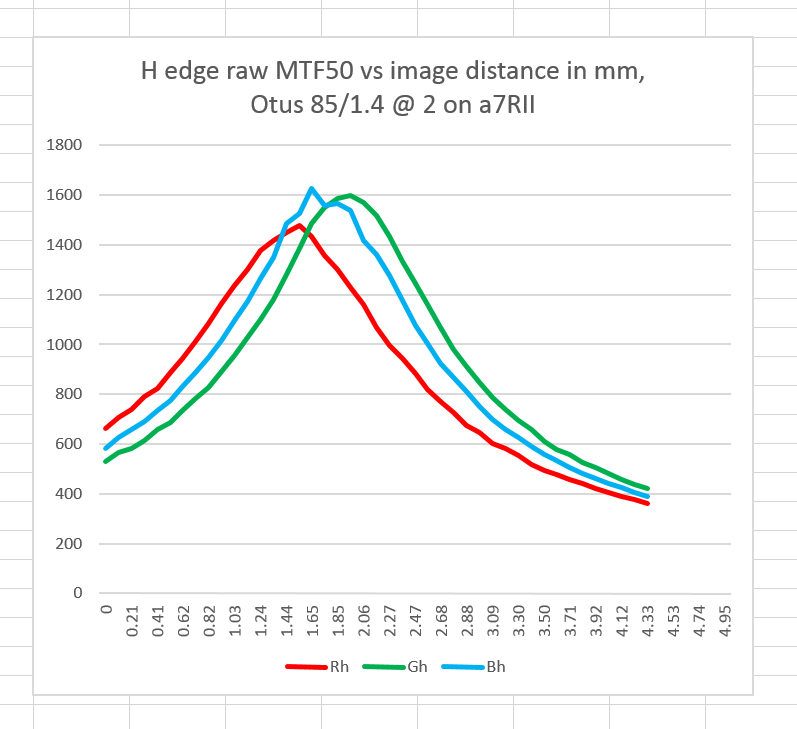
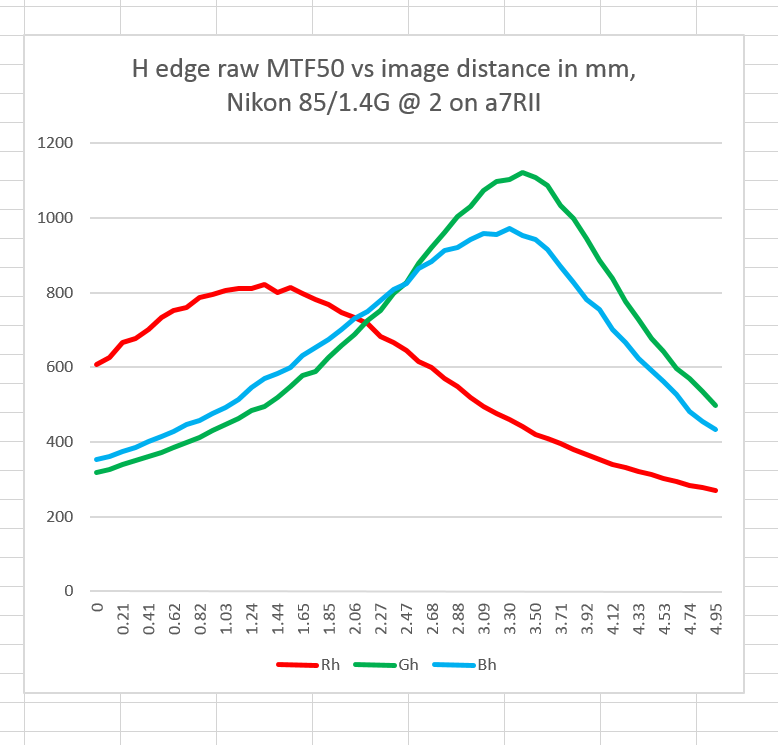
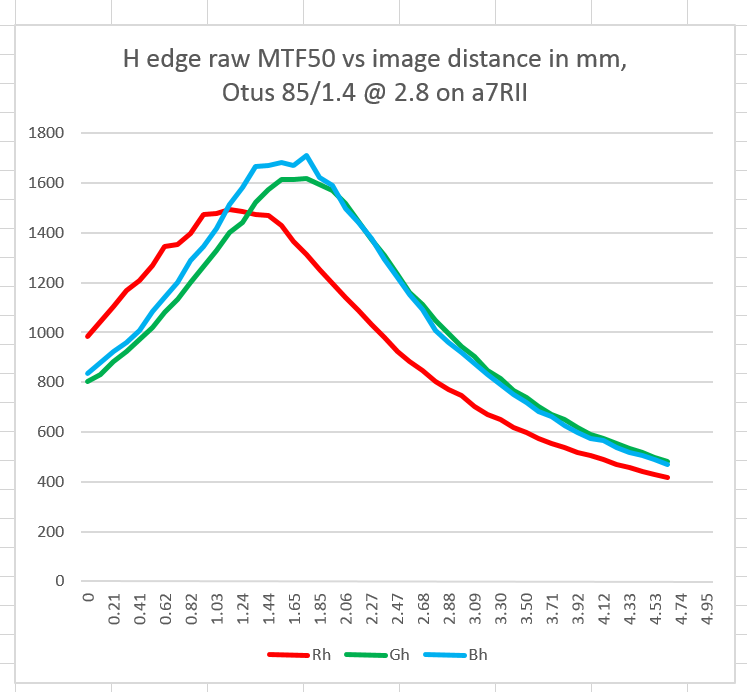
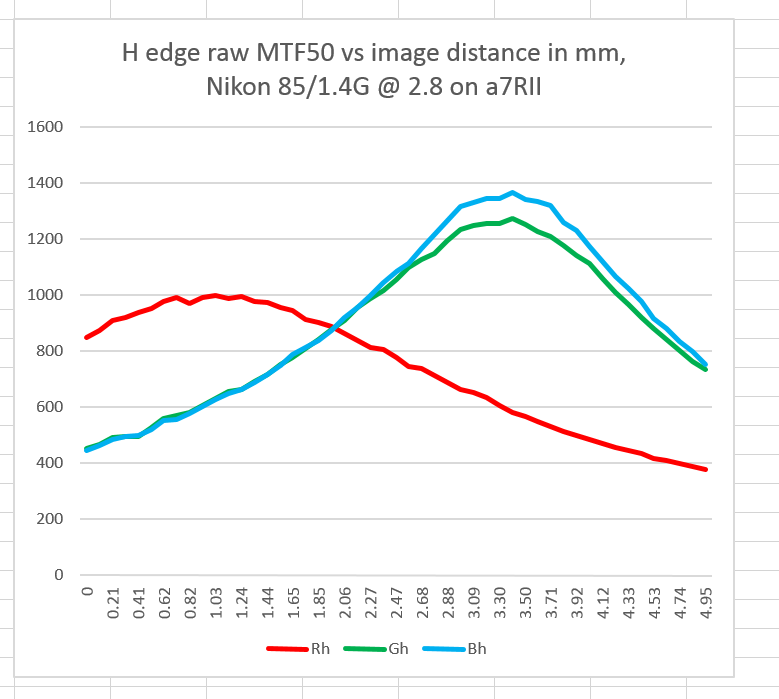
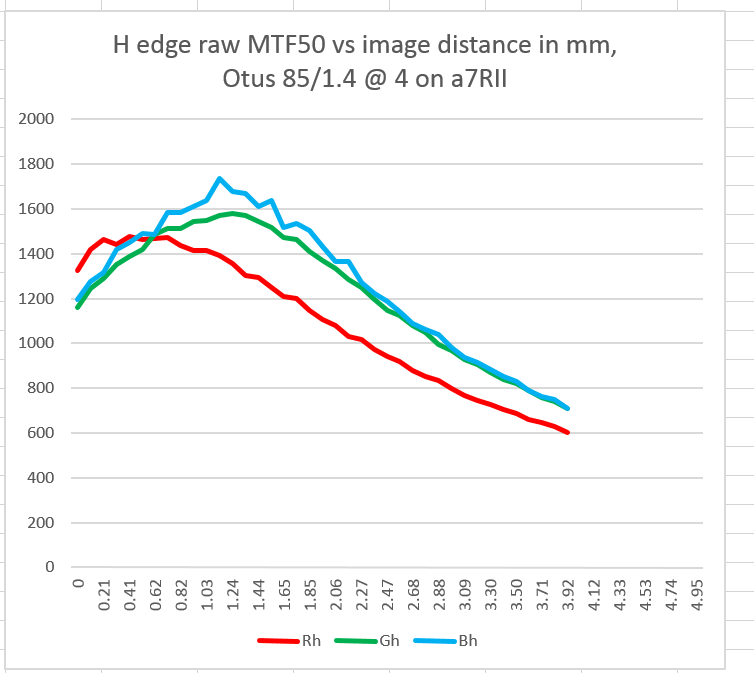
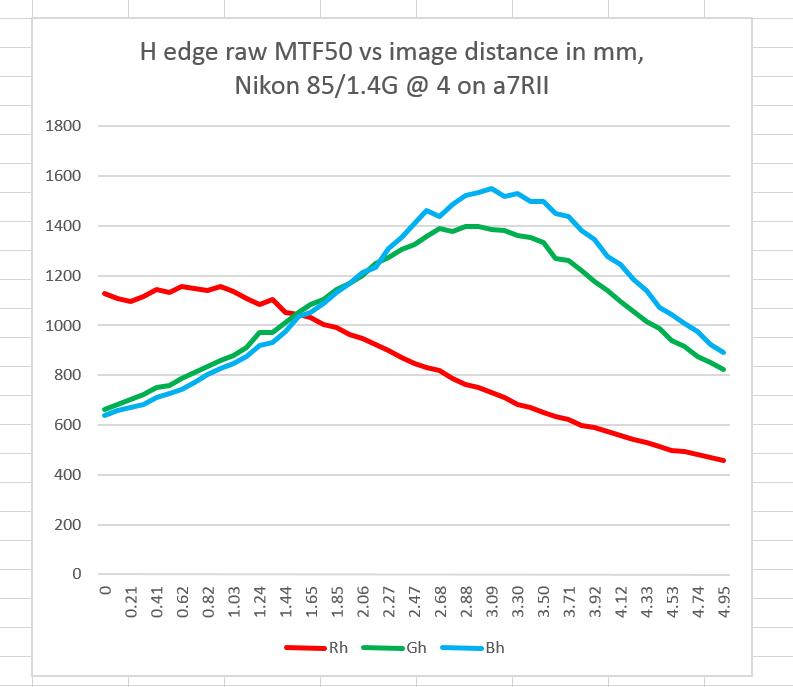
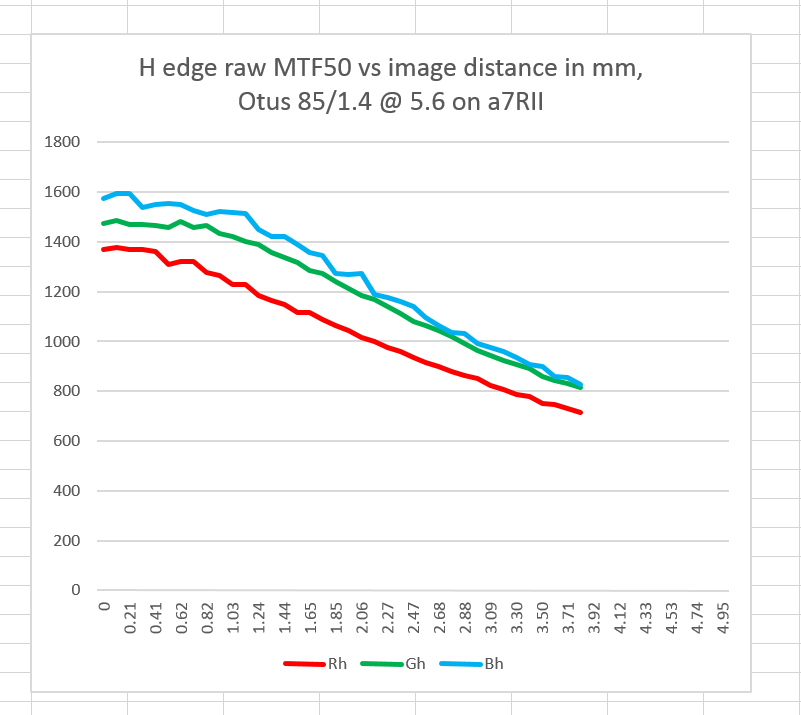
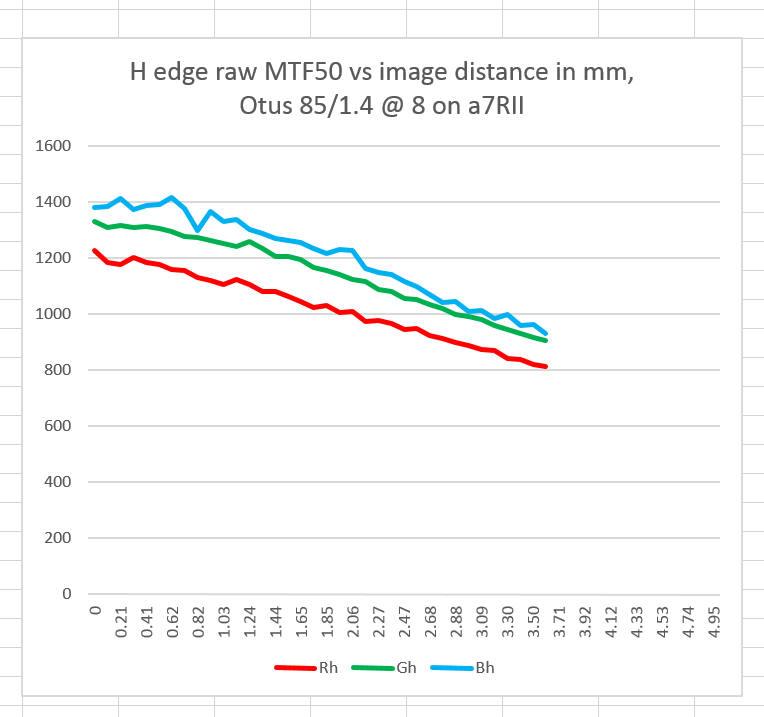
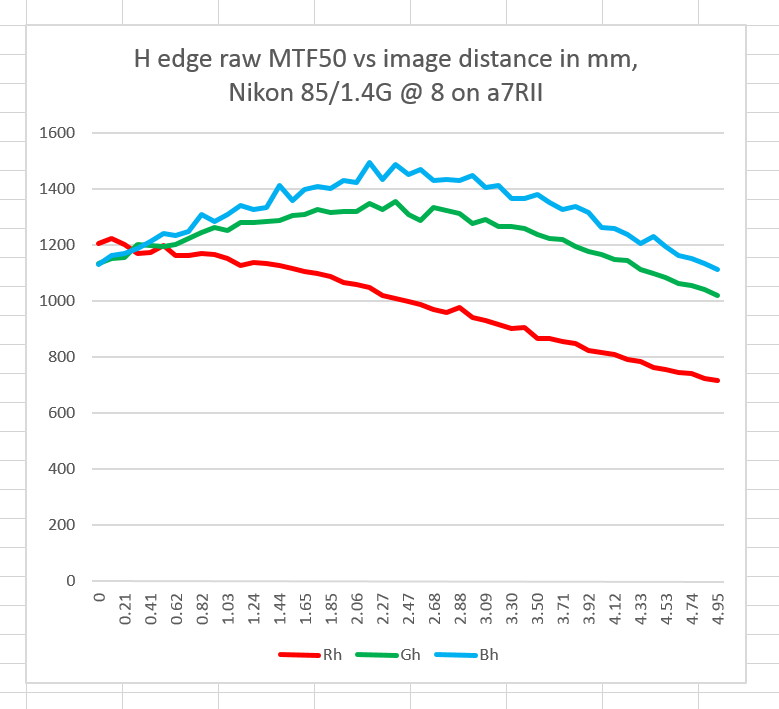
I am amazed at the fact that the Otus appears to give its best almost from right out of the box at f/2 – and by f/5.6 it seems to be already well on its way to being diffraction limited.
I guess it’s also clear that correcting the blue frequencies is easier than correcting the red ones.
Excellent work, Jim, it’s going to take me a while to understand what this all means. It would be worth starting a thread about these results.
Jack
I’ll be starting on in the Sony FF alpha forum on dpr as soon as I get the Sony 90G results done. They’re full frame files, so it’s taking DCRAW a while to get through them.
Jim
When we have a new and terrific way of measuring things like this, it would be great to have some kind of perpetual reference t get a sense of how visible these differences are.
Easier said than done, I know. I guess a set of standard 3 d scenes: perhaps a dummy head at portrait distances, a classic ruler on an angle — all presented at something like half life size which might, on most screens, correspond to the largest print someone is likely to make. Then correlating those to the graphs would help give a sense to people of what the image making consequences of different measurements are likely to be.
Not, of course, suggesting that you need to be the one doing it (very aware that when someone does as much good stuff for the community as you do, the danger is people start to think you owe it to them!!)
Is the some tangible/visible characteristic of the lens that these graphs can be related to? (e.g. micro contrast, colour saturation)
There are some examples here: http://toothwalker.org/optics/chromatic.html
Jim
I’ve read that the red channel focusing at a different depth in the Nikon is an intentional feature for portraits, softening the red channel for more pleasing skin rendering.
They seem to have blue and green pretty well buttoned up, so I am inclined to believe it. They do seem to be optimizing their designs for criteria other than sharpness, as evidenced by the 58/1.4.
Interesting. Did Nikon feature this in any of their literature? Maybe they have a landscape version somewhere…
Here’s another perspective. Are Otus users complaining about poor results when using their lenses for portraits>
Jim
I’ve definitely heard that perfect lenses can be too revealing for portraits. Not everyone likes their pores visible, after all. It’s probably not too hard to slightly blur just the red channel in post, but that’s another step to deal with.
At least we’ve moved away from actual soft focus filters and lenses though. Some of my parents’ wedding photos are soft focus and from a modern perspective they’re really unappealing. Makes me wonder when the “film filter” trend will go out of style…
The idea is that blood vessels in the skin show up in the red so by blurring the red channel you can make some of these unpleasant features vanish. The 105 DC does this very well indeed, preserving hair detail but making skin imperfections all but vanish without the need for post processing.
I would not use a Zeiss lens to photograph close-ups of people. I’ve done that but didn’t find the results acceptable so I went back to Nikon lenses which I find to produce pleasing results. I do think Zeiss is ok for landscape, technical subjects etc. as well as when photographing people at longer distances. But this is all very subjective. Some like Zeiss for portraits. I find the accentuation of blemishes and hard contrast gross.
It’s an interesting theory, but 400 to 800 cycles per picture height isn’t very blurry.
Jim